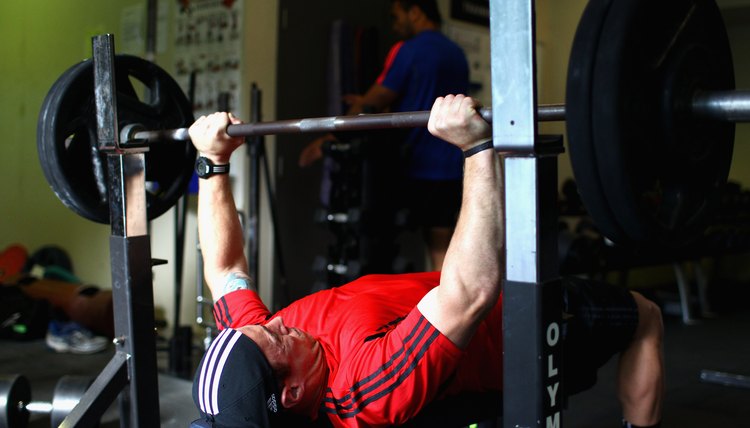Basic Natural Powerlifting Training

Natural powerlifting can mean two different things. A natural lifter is one who does not take any banned performance-enhancing substances, while natural or raw powerlifting can also mean competing without the aid of squat and deadlift suits or bench press shirts. These are made from tight material and aid the lifter in performing the exercises. Natural powerlifters are more prone to injuries and overtraining than geared lifters, so training needs to be intense enough to improve performance, but not so tough that you burn out.
General Training Plan
There are many different tried and tested powerlifting training plans, but one that is particularly popular is the Westside Barbell Method, designed by former elite powerlifter Louie Simmons. It involves training four days per week -- two upper body and two lower body days. These are split further into a speed day and a max effort day for the upper body, and the same for your lower sessions. The max effort days involve working up to a heavy set of one to five reps on your chosen exercise for the day, while the speed days consist of 6 to 12 sets of one to three reps using a light to moderate weight, lifted as fast as possible.
Main Exercises
The three competition exercises in powerlifting are squats, deadlifts and bench presses, and your training should revolve around these. Perform bench presses in all your max effort and speed upper body days. Do squats as a max effort exercise one week, with deadlifts on your speed days, then switch them around the following week. Correct technique is vital for optimal performance on the big three, so ask an experienced lifter or coach to assess your form and fix your weak points.
Accessory Movements
To break through plateaus, increase strength and decrease injury risk, include accessory exercises in your training. After your main exercise in each session, pick two or three other exercises. Tony Gentilcore, strength coach at Cressey Performance, advises using goblet squats, Anderson squats and box squats as accessories to regular squats. For deadlifts do good mornings and kettlebell swings, and board presses and dumbbell presses for your bench. Do each of these for three to four sets of 8 to 12 reps.
Progression
Natural lifters can't improve as quickly as geared lifters, so you need a method of progression that enables you to get steadily stronger without risking injury. Elite powerlifter and strength coach Gabriel Naspinski advises using a block periodization approach. Start with a four-week accumulation phase, where you keep the weights lighter and repetitions slightly higher. Move to a transmutation phase next, where you increase the weights and intensity, but lower your workout volume. Finish with a four-week realization phase, where you aim to hit personal bests in every session. Rest for two weeks, then begin again.
References
Writer Bio
Mike Samuels started writing for his own fitness website and local publications in 2008. He graduated from Peter Symonds College in the UK with A Levels in law, business and sports science, and is a fully qualified personal trainer, sports massage therapist and corrective exercise specialist with accreditations from Premier Global International.
